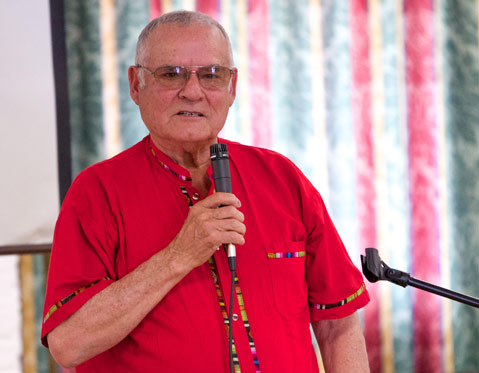Activists Call for District Elections
Lawsuit Looms Over Current At-Large System

If a group of area activists have their way, the say of Santa Barbara voters could soon be divided into districts. Approximately 75 people showed up to the Louise Lowry Davis Center last Saturday afternoon, most in favor of trading in the city’s at-large election system — meaning all City Council and mayoral candidates represent the entire city and earn the votes from voters citywide — for one based on districts, with each prospective councilmember voted on from designated areas and the mayor’s seat likely remaining a citywide position.
Opponents of the current method — Santa Barbara’s election-system pendulum has swung back and forth between the two approaches over its history — claimed that it discriminates against minority voters and candidates, possibly in violation of the state’s Voting Rights Act. And because an attempt in the 1990s to get voter approval for district elections failed (albeit narrowly), opponents said that the best way for them to get the system they want is to file a lawsuit against the city.
“California is a Latino state,” said attorney Barry Cappello, whose law firm is in the early stages of readying for such a lawsuit and would handle it pro bono. That only a handful of Latinos have sat on the City Council dais over the years, Cappello said, is “a terrible indictment of what the system is.” But a system based on districts, he said, “could get a lot more done on the ground.”
If or when the lawsuit is filed — Acting City Attorney Sarah Knecht said her office has yet to receive anything — it would place Santa Barbara in the company of other Southern California cities whose recent tussles over district elections have made headlines. In December, following a lawsuit filed by several residents alleging violation of the Voting Rights Act, the City of Palmdale was ordered by a judge to replace its at-large system with district elections and to do so in even-numbered years to coincide with statewide and national elections. Palmdale is now the first city in the state to have its system undergo court-ordered change as a result of the act, implemented in 2002. Anaheim and Whittier are dealing with similar challenges.
“I will give everything I can to this effort,” said Leo Martinez, who served one term as a councilmember in the 1970s and was one of the founders of La Casa de la Raza. He said he came back to town — he currently lives in New Mexico — to help bring the issue back to the spotlight. Speaking of Cappello, whom he dealt with when Cappello served as the city’s attorney, Martinez said, “If he goes to court, we will win.”
While most of the meeting’s attendees voiced their support for change, some said district elections aren’t the only or best way to more widely represent the city’s residents. “The votes of everybody are needed to elect good people,” said activist Mickey Flacks, adding that although district elections could mean more Latinos in office, it could also mean more Republicans. Environmental consultant David Pritchett, married to Councilmember Cathy Murillo, agreed, expressing his concerns that such a system would “make a permanent minority” on the council and that district boundaries — which weren’t discussed on Saturday — could lead to gerrymandering. Pritchett added that districts would diminish residents’ representation from seven elected officials to one.
“I’m not ready to give up on empowering everybody in this city to vote and to run themselves,” said Murillo, the only minority to serve on the council since Babatunde Folayemi (who served 2002-2004) and the only Latino since Gil Garcia (1991-2001). After being put on the spot, Murillo said that increasing the number of minorities selected for the city’s various boards and committees — Knecht said the council currently selects who takes those positions from a pool of applicants — could help with representation concerns. Other suggestions included implementing even-year elections and changing local campaign finance rules.
Although a representative from the activist organization PODER didn’t speak on Saturday, the organization has said that they would support the lawsuit, and Marcos Vargas, the executive director of the Central Coast Alliance United for a Sustainable Economy (CAUSE), said his group, although without a formal stance, is reviewing what is being proposed. Vargas pointed to CAUSE’s new efforts — spurred largely by the Santa Maria Planning Commission’s recent approval of a federal Immigration and Customs Enforcement (ICE) facility there, much to the ire of thousands of residents — to get a Santa Maria district-elections measure on the November ballot.
Larry Herrera, currently the city clerk for Long Beach and formerly the assistant clerk-recorder-registrar for Santa Barbara County, spoke at Saturday’s meeting in support of district voting, which Long Beach employs. He called the cities of Long Beach and Santa Barbara similar in terms of, among other things, their beauty and natural resources and questioned whether they will overlap in election systems. “Where does Santa Barbara stand?” he asked. “Which way will you go?”



